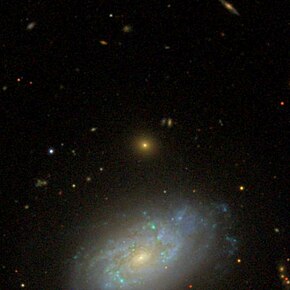NGC 3950 is an elliptical galaxy of type E,[1] in Ursa Major. Its redshift is 0.074602,[2] meaning NGC 3950 is 1.03 billion light-years or 316 Mpc from Earth, which is within the Hubble distance values.[3] This high redshift makes NGC 3950 one of the furthest New General Catalogue objects.[4]
| NGC 3950 | |
|---|---|
 | |
| Observation data (J2000 epoch) | |
| Constellation | Ursa Major |
| Right ascension | 11h 53m 41.41s |
| Declination | +47d 53m 04.46s |
| Redshift | 0.074602 |
| Heliocentric radial velocity | 22,365 km/s |
| Distance | 1.030 Gly (315 Mpc) |
| Apparent magnitude (V) | 15.7 |
| Apparent magnitude (B) | 16.7 |
| Surface brightness | 13.2 |
| Characteristics | |
| Type | E, E0;cand. dwarf |
| Apparent size (V) | 0.30' x 0.3' |
| Other designations | |
| PGC 37294, MCG +08-22-030, BTS 051, HOLM 301B | |
NGC 3950 has apparent dimensions of 0.30 x 0.3 arcmin, meaning the galaxy is 90,000 light-years across.[5] It was discovered by Lawrence Parsons[6][7] on April 27, 1875, and he described it as, "extremely faint, 2.6 arcmin north of h 1009".[6]
In a research article published in 1990,[8] NGC 3950 was believed to be a dwarf galaxy, and a close companion of a larger spiral galaxy, NGC 3949.[9] But further research involving measuring its redshift in 2005 showed NGC 3950 is much further away in the background.[10] Together with NGC 3949, they both form an optical galaxy pair called HOLM 301.[11]
References
edit- ^ "HyperLeda -object description". atlas.obs-hp.fr. Retrieved 2024-05-16.
- ^ "NGC 3950 - galaxy. Description NGC 3950:". kosmoved.ru. Retrieved 2024-05-16.
- ^ "NED Distance Results for NGC 3950". ned.ipac.caltech.edu. Retrieved 2024-05-16.
- ^ Lowery, Jimi. "Chasing Billion Year Old Light" (PDF).
- ^ "Revised NGC Data for NGC 3950". spider.seds.org. Retrieved 2024-05-16.
- ^ a b "New General Catalog Objects: NGC 3950 - 3999". cseligman.com. Retrieved 2024-05-16.
- ^ "List of NGC/IC observers". www.klima-luft.de. Retrieved 2024-05-16.
- ^ Binggeli, B.; Tarenghi, M.; Sandage, A. (1990-02-01). "The abundance and morphological segregation of dwarf galaxies in the field". Astronomy and Astrophysics. 228: 42–60. ISSN 0004-6361.
- ^ "Your NED Search Results". ned.ipac.caltech.edu. Retrieved 2024-05-16.
- ^ "Data products: Getting Spectra - SDSS DR4". classic.sdss.org. Retrieved 2024-05-16.
- ^ Holmberg, Erik (1937-01-01). "A Study of Double and Multiple Galaxies Together with Inquiries into some General Metagalactic Problems". Annals of the Observatory of Lund. 6: 1–173.